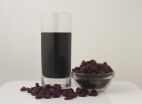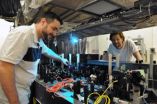(Press-News.org) The paleoclimate record for the last ice age — a time 21,000 years ago called the "Last Glacial Maximum" (LGM) — tells of a cold Earth whose northern continents were covered by vast ice sheets. Chemical traces from plankton fossils in deep-sea sediments reveal rearranged ocean water masses, as well as extended sea ice coverage off Antarctica. Air bubbles in ice cores show that carbon dioxide in the atmosphere was far below levels seen before the Industrial Revolution.
While ice ages are set into motion by Earth's slow wobbles in its transit around the sun, researchers agree that the solar-energy decrease alone wasn't enough to cause this glacial state. Paleoclimatologists have been trying to explain the actual mechanism behind these changes for 200 years.
"We have all these scattered pieces of information about changes in the ocean, atmosphere, and ice cover," says Raffaele Ferrari, the Breene M. Kerr Professor of Physical Oceanography in MIT's Department of Earth, Atmospheric and Planetary Sciences, "and what we really want to see is how they all fit together."
Researchers have always suspected that the answer must lie somewhere in the oceans. Powerful regulators of Earth's climate, the oceans store vast amounts of organic carbon for thousands of years, keeping it from escaping into the atmosphere as CO2. Seawater also takes up CO2 from the atmosphere via photosynthesizing microbes at the surface, and via circulation patterns.
In a new application of ocean physics, Ferrari, along with Malte Jansen PhD '12 of Princeton University and others at the California Institute of Technology, have found a new approach to the puzzle, which they detail in this week's Proceedings of the National Academy of Sciences.
Lung of the ocean
The researchers focused on the Southern Ocean, which encircles Antarctica — a critical part of the carbon cycle because it provides a connection between the atmosphere and the deep ocean abyss. Ruffled by the winds whipping around Antarctica, the Southern Ocean is one of the only places where the deepest carbon-rich waters ever rise to the surface, to "breathe" CO2 in and out.
The modern-day Southern Ocean has a lot of room to breathe: Deeper, carbon-rich waters are constantly mixing into the waters above, a process enhanced by turbulence as water runs over jagged, deep-ocean ridges.
But during the LGM, permanent sea ice covered much more of the Southern Ocean's surface. Ferrari and colleagues decided to explore how that extended sea ice would have affected the Southern Ocean's ability to exchange CO2 with the atmosphere.
Shock to the system
This question demanded the use of the field's accumulated knowledge of ocean physics. Using a mathematical equation that describes the wind-driven ocean circulation patterns around Antarctica, the researchers calculated the amount of water that was trapped under the sea ice by currents in the LGM. They found that the shock to the entire Earth from this added ice cover was massive: The ice covered the only spot where the deep ocean ever got to breathe. Since the sea ice capped these deep waters, the Southern Ocean's CO2 was never exhaled to the atmosphere.
The researchers then saw a link between the sea ice change and the massive rearrangement of ocean waters that is evident in the paleoclimate record. Under the expanded sea ice, a greater amount of upwelled deep water sank back downward. Southern Ocean abyssal water eventually filled a greater volume of the entire midlevel and lower ocean — lifting the interface between upper and lower waters to a shallower depth, such that the deep, carbon-rich waters lost contact with the upper ocean. Breathing less, the ocean could store a lot more carbon.
A Southern Ocean suffocated by sea ice, the researchers say, helps explain the big drop in atmospheric CO2 during the LGM.
Dependent relationship
The study suggests a dynamic link between sea-ice expansion and the increase of ocean water insulated from the atmosphere, which the field has long treated as independent events. This insight takes on extra relevance in light of the fact that paleoclimatologists need to explain not just the very low levels of atmospheric CO2 during the last ice age, but also the fact that this happened during each of the last four glacial periods, as the paleoclimate record reveals.
Ferrari says that it never made sense to argue that independent changes drew down CO2 by the exact same amount in every ice age. "To me, that means that all the events that co-occurred must be incredibly tightly linked, without much freedom to drift beyond a narrow margin," he says. "If there is a causality effect among the events at the start of an ice age, then they could happen in the same ratio."
INFORMATION:
The research was supported by the National Science Foundation.
Solving the puzzle of ice age climates
Researchers look to the Southern Ocean for an explanation of the 'Last Glacial Maximum'
2014-06-02
ELSE PRESS RELEASES FROM THIS DATE:
Seniors who exercise regularly experience less physical decline as they age
2014-06-02
COLUMBIA, Mo. –The majority of adults aged 65 and older remains inactive and fails to meet recommended physical activity guidelines, previous research has shown. However, these studies have not represented elders living in retirement communities who may have more access to recreational activities and exercise equipment. Now, researchers at the University of Missouri found that older adults in retirement communities who reported more exercise experienced less physical decline than their peers who reported less exercise, although many adults — even those who exercised — did ...
CDC report: Patients harmed after health-care providers steal patients' drugs
2014-06-02
Rochester, MN, June 2, 2014 – When prescription medicines are stolen or used illegally, it is called drug diversion. One aspect of drug diversion that is not well recognized involves health care providers who steal controlled substances for their personal use. A report authored by experts from the Centers for Disease Control and Prevention (CDC) --published today in Mayo Clinic Proceedings -- outlines outbreaks of infections that have occurred as a result of health care providers stealing or tampering with their patients' medications. These outbreaks revealed gaps in prevention, ...
Rensselaer researchers predict the electrical response of metals to extreme pressures
2014-06-02
Troy, N.Y. – Research published today in the Proceedings of the National Academy of Sciences makes it possible to predict how subjecting metals to severe pressure can lower their electrical resistance, a finding that could have applications in computer chips and other materials that could benefit from specific electrical resistance.
The semiconductor industry has long manipulated materials like silicon through the use of pressure, a strategy known as "strain engineering," to improve the performance of transistors. But as the speed of transistors has increased, the limited ...
Study shows impact of tart cherries on inflammation and oxidative stress after cycling
2014-06-02
Cyclists who drank Montmorency tart cherry juice concentrate before a three-day simulated race experienced less inflammation and oxidative stress compared to those who drank another beverage, according to a recent U.K. study published in the journal Nutrients.
A research team led by Dr. Glyn Howatson with PhD student Phillip Bell at Northumbria University gave 16 well-trained, male cyclists about 1 ounce (30 ml) of Montmorency tart cherry juice concentrate mixed with water (equivalent to 90 whole Montmorency tart cherries per serving), or a calorie-matched placebo, twice ...
Transition to ICD-10 may mean financial, data loss for pediatricians
2014-06-02
Pediatricians may lose money or data during the mandated conversion from the current International Classification of Diseases (ICD) to its new version, according to University of Illinois at Chicago researchers.
The study is published in Pediatrics.
The ICD codes are used in managing all aspects of health care, from insurance reimbursement to staffing decisions to supply procurement to research. Pediatricians use a variety of ICD-9 codes from many different categories, including well child care, infectious diseases, injury and genetic disorders.
The ICD-10-CM, scheduled ...
Here come the 'brobots'
2014-06-02
WASHINGTON D.C. June 2, 2014 -- A team of researchers at the University of Twente (Netherlands) and German University in Cairo (Egypt) has developed sperm-inspired microrobots, which can be controlled by oscillating weak magnetic fields.
Described in a cover article in the journal Applied Physics Letters, which is from AIP Publishing, the 322 micron-long robots consist solely of a head coated in a thick cobalt-nickel layer and an uncoated tail. When the robot is subjected to an oscillating field of less than five millitesla – about the strength of a decorative refrigerator ...
MRI-guided laser procedure provides alternative to epilepsy surgery
2014-06-02
May 30, 2014 – For patients with mesial temporal lobe epilepsy (MTLE) that can't be controlled by medications, a minimally invasive laser procedure performed under MRI guidance provides a safe and effective alternative to surgery, suggests a study in the June issue of Neurosurgery , official journal of the Congress of Neurological Surgeons . The journal is published by Lippincott Williams & Wilkins , a part of Wolters Kluwer Health.
"Real-time magnetic resonance-guided stereotactic laser amygdalohippocampotomy (SLAH) is a technically novel, safe and effective alternative ...
University of Toronto physicists take quantum leap toward ultra-precise measurement
2014-06-02
TORONTO, ON – For the first time, physicists at the University of Toronto (U of T) have overcome a major challenge in the science of measurement using quantum mechanics. Their work paves the way for great advances in using quantum states to enable the next generation of ultra-precise measurement technologies.
"We've been able to conduct measurements using photons – individual particles of light – at a resolution unattainable according to classical physics," says Lee Rozema, a Ph.D. candidate in Professor Aephraim Steinberg's quantum optics research group in U of T's Department ...
One in 4 children with leukemia not taking maintenance medication, study shows
2014-06-02
(WASHINGTON, June 2, 2014) – An estimated 25 percent of children in remission from acute lymphocytic leukemia (ALL) are missing too many doses of an essential maintenance medication that minimizes their risk of relapse, according to a study published online today in Blood, the Journal of the American Society of Hematology. The study also reports that maintenance medication adherence was lower in African American and Asian children in remission from ALL than in non-Hispanic white children, with 46 percent of African Americans and 28 percent of Asians not taking enough to ...
No apparent link between chronic cerebrospinal venous insufficiency and MS
2014-06-02
There appears to be no link between chronic cerebrospinal venous insufficiency and multiple sclerosis (MS), according to new research published in CMAJ (Canadian Medical Association Journal).
In 2009, Dr. Paolo Zamboni postulated that chronic cerebrospinal venous insufficiency is a cause of MS, an inflammatory disease of the central nervous system that affects people in northern climates in particular. Published evidence has not been able to find a link to MS, and no one has been able replicate his findings. Several recent studies have shown an association between ultrasound-diagnosed ...
LAST 30 PRESS RELEASES:
Key lung immune cells can intensify allergic reactions
Do hormones explain why women experience more gut pain?
New materials conduct ions in solids as easily as in liquids
Breakthrough of the Year: Renewable energy begins to eclipse fossil fuel-based sources
LLM use is reshaping scientific enterprise by increasing output, reducing quality and more
Introducing LightGen, a chip for ultra-fast, ultra-efficient generative AI
Astronomers see fireworks from violent collisions around nearby star
ACC/AHA issue new guideline on managing congenital heart disease in adults
Cosmic crash caught on camera
Is talented youth nurtured the wrong way? New study shows: top performers develop differently than assumed
Ants: An untapped resource in the development of antibiotics?
Archaeologists use AI to create prehistoric video game
Mitochondria migrate toward the cell membrane in response to high glucose levels
Tiny viral switch offers hope against drug-resistant bacteria
Most parents aware of early peanut introduction guidelines, but confused about details
HPV vaccine can protect against severe lesions of the vulva and vagina
Virtual care provision and emergency department use among children and youth
Quadrivalent HPV vaccine and high-grade vulvovaginal lesions
Insights into dry eyes gained from stem cell-derived tear glands
Researchers identify 166 human pluripotent stem cell lines available for use in clinical applications
Europa Clipper instrument uniquely observed interstellar comet 3I/ATLAS
UN University Report challenges climate change as sole trigger of Syrian Civil War, exposing governance failures in drought response
Real estate investment trust (REIT) acquisition associated with hospital closure and bankruptcy
New Raman imaging system detects subtle tumor signals
Boston Children’s receives a $7.5 million grant from Aligning Research to Impact Autism (ARIA) to provide clinical research coordination for the IMPACT Network
Spray-on antibacterial coating offers new protection for plants against disease and drought
ESMT Berlin study: What makes a first offer successful in negotiations
Groundbreaking ceremony marks the beginning of CTAO-South Array construction in Chile
Why swearing makes you stronger
What prevents more cancer patients from enrolling in potentially life-saving clinical trials?
[Press-News.org] Solving the puzzle of ice age climatesResearchers look to the Southern Ocean for an explanation of the 'Last Glacial Maximum'


